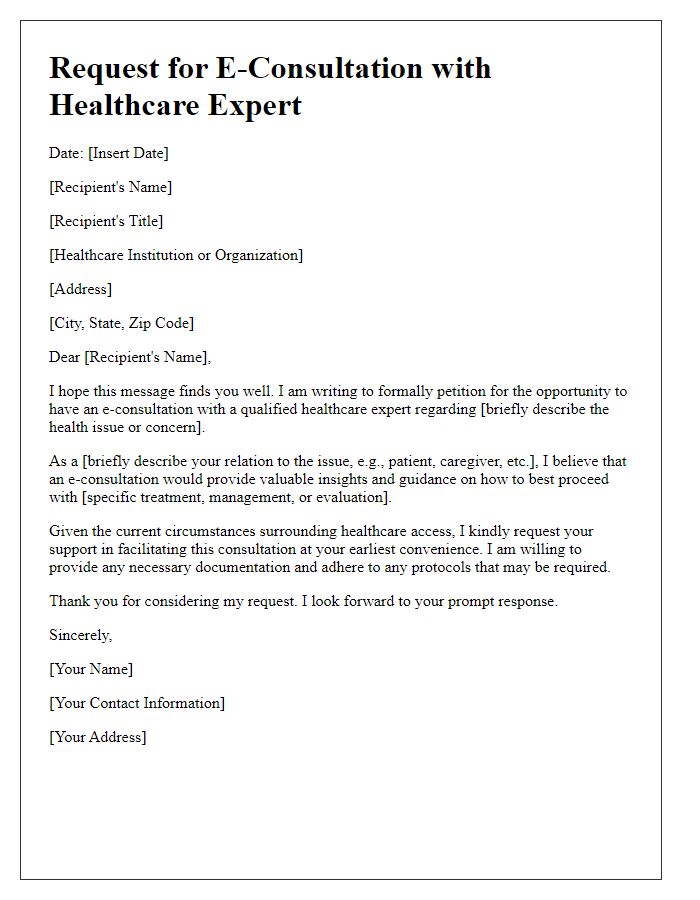Are you looking to schedule a telehealth appointment with your doctor but unsure where to start? Crafting a concise and clear letter can make the process smooth and efficient. In this guide, we'll provide you with a straightforward template that outlines all the essential details, ensuring your request is communicated effectively. Let's dive in so you can get the care you need from the comfort of your own home!

Patient Information and Contact Details
Patients seeking telehealth appointments can streamline their healthcare experience by submitting relevant information. Patient identification includes full name, date of birth, and medical record number that ensures accurate recognition within the healthcare system. Contact details such as phone number and email address facilitate communication, allowing healthcare providers to send appointment confirmations and reminders efficiently. Insurance information may also be required, including provider name and policy number, to confirm coverage for telehealth services. Additionally, specifying the preferred method of appointment--whether via video call or phone--can support personalization of the telehealth encounter.
Reason for Telehealth Appointment Request
Telehealth appointments offer convenient access to medical care for patients seeking assistance from healthcare providers remotely. Reasons for requesting telehealth appointments vary, including managing chronic conditions such as diabetes affecting approximately 34 million Americans or seeking immediate consultations for acute symptoms like persistent cough or high fever, which could indicate infections such as COVID-19 or influenza. Patients may also require follow-ups after surgeries, specifically orthopedic procedures, to assess recovery without the need for an in-person visit. Additionally, mental health consultations via telehealth have become increasingly necessary, with teletherapy sessions enabling individuals to receive support for conditions like anxiety or depression, affecting nearly 20% of adults in the United States.
Preferred Date and Time for Consultation
Telehealth appointments enable patients to access healthcare remotely, utilizing video conferencing technology. Scheduling a consultation requires specifying a preferred date and time, ideally providing two or three options for flexibility. For instance, many patients prefer evenings or early mornings due to work commitments. Each telehealth platform, such as Zoom or Doxy.me, ensures secure interactions, emphasizing patient confidentiality and comfort. Access to reliable internet connections (with speeds of at least 3 Mbps for video calls) is essential for a smooth experience. Finally, having pertinent medical history available during the appointment streamlines the consultation process, making it more efficient and effective.
Specific Medical Concerns and Symptoms
Telehealth appointments offer convenient access to healthcare professionals, particularly for individuals experiencing specific medical concerns and symptoms. For example, patients presenting symptoms such as persistent headaches, severe abdominal pain, or unusual rashes should seek timely consultation. While scheduling an appointment with a primary care physician, ensure to specify your location (e.g., New York City) and preferred communication method (video call or phone). Documentation of symptoms, including duration and intensity (scale of 1 to 10), should be prepared to assist the doctor in diagnosing effectively. Time slots available for telehealth sessions should also be explored, as this can expedite the process of receiving care.
Insurance and Payment Information
Patients seeking telehealth appointments with healthcare providers must ensure proper insurance and payment information is readily available. This includes verifying coverage details from insurance companies, such as Aetna, Blue Cross Blue Shield, or Medicare, which often stipulate specific telehealth provisions. Necessary payment information should encompass co-pay amounts, deductible status, and accepted payment methods like credit cards or Health Savings Accounts (HSAs). Telehealth platforms, such as Zoom for Healthcare or Doxy.me, may also require patients to confirm technology compatibility, such as camera and microphone functionality for effective consultations. Providing this information streamlines the appointment-setting process and enhances overall care experience.
Letter Template For Requesting Telehealth Appointment With Doctor Samples
Letter template of request for telehealth appointment with primary care physician.

Letter template of application for online health assessment with healthcare provider.

Letter template of appeal for remote medical appointment with physician.

Letter template of solicitation for telemedicine visit with family doctor.

Letter template of demand for distance health check with medical practitioner.









Comments